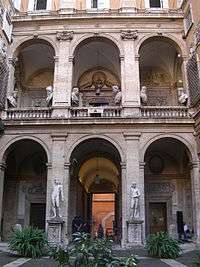Mattei family
The House of Mattei was one of the most powerful noble families of Rome during the Middle Ages and early modern era, holding high positions in the papal curia and government office. The family amassed significant art collections under art enthusiasts such as Ciriaco Mattei.

The Mattei gave eight Cardinals to the Catholic Church, among them Girolamo Mattei (1586), Gaspare Mattei (1643), Alessandro Mattei (1803), Mario Mattei (1832), Lorenzo Girolamo Mattei (1833) and (as late as 1875) Ruggero Luigi Emidio Antici Mattei. The founder of one powerful branch of the Mattei was Giovanni Giacomo Mattei.[1]
History
Mattei family lines reportedly went back to an early Roman family, the Papareschi, and their ancestors included Pope Innocent II (1130–1143). In the 1350s the family moved to the Rione Sant Angelo, and they eventually built six residences in the block called the Isola Mattei. The Mattei established themselves in politics and banking and were closely connected to the politics of the Church; later to its military conquests.
Though they lived in the Roman Ghetto, the historic Jewish quarter, they were Roman Catholic. When Pope Paul IV decided to build a wall around the Ghetto in 1555, at the invitation of the Roman Jews who wished to be isolated on the Sabbath, the Mattei were given a key to the gate by the Jews.[2]
Property
In Rome the Mattei owned five palazzi in the rione, or quarter, of Sant'Angelo (together they formed the so-called "isola dei Mattei": see Palazzo Mattei), and one in Trastevere. Moreover, they owned Villa Celimontana in the rione Celio. The family assumed control over the bridges closest to their ancestral palace during the papal interregnum, levying charges on various types of traffic, including the Jews who lived in the nearby ghetto when burying their dead outside the city.
The purchase of the territory of Giove in 1597[3] entitled the Mattei to the title Marquis di Giove (raised in 1643 to a dukedom) in addition to their older title of Nobile Romano. Other Mattei titles included Duke of Paganica and Marquis di Belmonte.
In 1580–1585, Muzio Mattei commissioned one of the most famous fountains in Rome, the Fontana delle Tartarughe (Turtle Fountain) in front of his residence.
Family tree
House of Mattei family tree during the 16th and 17th centuries:[4]
| Alessandro Mattei | Emilia Mazzatosta | Muzio Mattei | |||||||||||||||||||||||||||||||||||||||||||||
| Ciriaco Mattei | Giulia Matuzzi | Cardinal Girolamo Mattei | Asdrubale Mattei Marquis di Giove | Costanza Gonzaga | |||||||||||||||||||||||||||||||||||||||||||
| Giovanni Batista Mattei | Alessandro Mattei | Girolamo Mattei Duke of Giove | Luigi Mattei Marquis di Belmonte | Paolo Mattei | |||||||||||||||||||||||||||||||||||||||||||
Differentiation
Like many noble Italian families of the period, sons were often named in honour of their predecessors. It the case of the Mattei, the same christian names are given many times over. The Alessandro Mattei listed in the final branch of the family tree above, though sources suggests he undertook an ecclesiastic career, is not Alessandro Mattei (1744–1820). Ironically though, the latter Alessandro was also nephew to a Luigi Mattei; born in 1702[5] who later became a cardinal (not the military Luigi Mattei listed above).
Though direct relations are not clear, biographies of contemporaries Alessandro Mattei (1744–1820), Lorenzo Girolamo Mattei (1748–1833), Mario Mattei (1792–1870) and Ruggero Luigi Emidio Antici Mattei (1811–1883) suggest they were all related.
See also
References
- Genealogy of Mattei and Antici Mattei
- Fontana delle tartarughe, the iconography of a Roman fountain by Anne Kristine Tagstad
- Mattei home
- Caravaggio's Taking of Christ by Francesca Cappelletti
- Florida International University - Alessandro Mattei